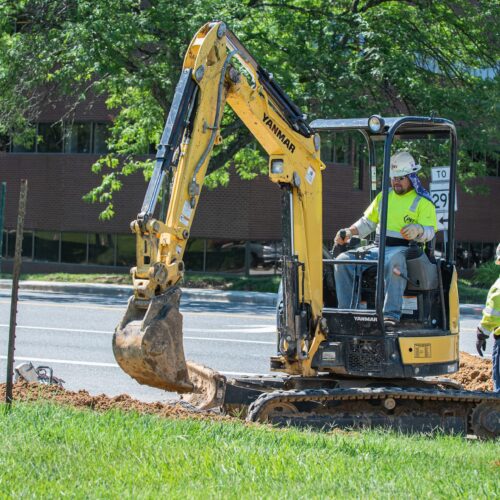Some Known Details About Trencher
Wiki Article
How Grading Contractors can Save You Time, Stress, and Money.
Table of ContentsTop Guidelines Of Concrete ContractorsGet This Report on Excavation Contractors Near MeAll about Concrete ContractorsThe smart Trick of Concrete Contractors That Nobody is Talking AboutThe 15-Second Trick For Trencher


Scrapers or Pans dig deep into dirt in one area, haul and unload the soil in another area (mini excavator). It is tough to match the performance of scrapers for cut/fill soil operation if the haul range is less then a mile. Scrapes are usually drawn by a rubber tire wheel tractor and are in some cases pushed with the cut location by an excavator.
There are often times that scrapers are not used for site grading and also a dump vehicle is used: the haul might be to long, the haul might go across roadways where scrapes are not allowed, tough rock may be encountered, devices availability, etc. Discard trucks remain in typical use as well as probably call for little conversation.
"Rock body" beds, on the other hand, have no tailgates and can unload any dimension rock, although their volume capacity is decreased. Compaction Tools raises the density of the soil and in some instances provides a smooth, rolled surface area.
Excavating Contractors Can Be Fun For Anyone
From a straightforward test pit to percussion drilling to core exploration the proprietor has significantly extra costly alternatives that generate increasingly far better information concerning the site underground. For instance, the Proprietor on a 100,000 SF structure task may license twenty dull places with split spoon soil samples taken until rock is reached and afterwards core samples of rock.Knowing the kind as well as quality of rock (from the core examples) and area of rock (from the dirts boring) is an actual advantage in jobsite planning. Alternatively, the Proprietor of a 100,000 SF structure may choose to wage no geotechnical screening whatsoever. The choice regarding geotechnical screening is generally made by a Proprietor without any input from the Construction Manager.
An expertise of the approximate place of the rock assists the Construction Supervisor to plan the series of steps following rock excavation. If rock is in one edge of a huge building job, for example, the earth excavation might begin at the contrary end of the structure in order to begin foundation work soonest.
Beginning the structure job early would be a great concept if the rock might be removed by ripping. Nonetheless, if the rock is very hard and calls for significant blasting, it may be sensible to hold structure job until the blasting is completed. The Building and construction Supervisor should work with these sorts of decisions as well as utilize all the technical date offered.
4 Easy Facts About Demolition Explained
Unclassified excavation specifies that all rock or other unforeseen materials (omitting harmful materials) run into in the sitework will be the duty of the Contractor at no modification in contract price. An unclassified excavation is simpler from a book-keeping standpoint and puts the obligation for geotechnical problems onto the Sitework Service provider.Just How Water Affects Sitework? It's fantastic what a heavy rainfall can do to a building and construction project. Prior to the rainfall, the website may be dry, hefty devices successfully relocating earth, the various other professions smoothly executing their job. Within hours the project can be a sloppy, mud-hole with worker efficiency cut to regarding 10%.
In most areas of the world, the Building Manager have to bear in mind an easy truth: IT WILL RAIN. Good planning can lessen the damages and also interruption of a heavy rain to a jobsite. Frequently the excavation and grading is left to the Sitework Professional (and their Foremen is responsible to oversee as well as direct the heavy tools and operators).
For That Reason the Construction Supervisor must be continually familiar with what rainfall will certainly do to the project site. It is not uncommon for the Sitework Supervisor to work their heavy devices for optimal effectiveness and hope it does not rainfall. One of the very best means to prepare for rainfall is to slope all grades to drain pipes as well as to smooth rolled the surface before a rain.
What Does Grading Contractors Do?
The Building Supervisor need to be perceptive sufficient to guarantee that hefty rain does not quit working on the project longer than necessary. Daily discussions with Sitework Foremen may be required to accomplish this goal. Any time excavation is required listed below the existing aquifer on a task, the procedure of dewatering must be taken into consideration.In an absolutely cohesive soil, the water travels so slowly via the clay or silt that dewatering is not usually essential for the relatively short time of excavation. Dewatering may be required for a single sites footing excavation or for an entire project site. One of the most usual dewatering techniques are trench drains pipes, deep wells as well as well factors.

Ground water seepage can additionally be reduced by cutoff methods such as sheet loading. High dewatering costs have paled the profit margins on far also lots of jobs.
This option needs to constantly be taken into consideration when examining the prospect of dewatering. Certainly the alternative is only viable if gravity can run the water to lower ground. Trench drains can be reduced with a backhoe as well as full of a crude, granular material (# 4 stone for instance), yet treatment must be worked out in selecting the water electrical outlet type and also location.
The smart Trick of Excavator That Nobody is Talking About
A siphon, by definition, utilizes climatic pressure to carry water from one altitude, up over a challenge, to a lower altitude. The pipelines in a siphon system must be airtight and some resourcefulness is usually called for to entirely fill up the siphon pipe. The siphon pipe need to be complete for the siphon to begin.A deep well contains a pump, hose pipe as well as an upright well casing. The pump consumption is at the base of the well casing (typically some smashed rock is put there as a filter tool) (excavator). The water description is inflated the hose pipe, out of the well housing, and also to an appropriate discharge location.
In a crude sand, for instance, a large area can be pumped to near the pump intake elevation. A much less permeable soil, on the various other hand, lowers the effectiveness of a deep well. Because the pump is usually at the bottom of the deep well, there are no height constraints due excavator to vacuum lift, and deep wells can lower the groundwater over 50 feet.
On the base of the wellpoint there is a 2 foot long display and valve, water jets out of this valve and develops an opening into which the wellpoint pipeline can be lowered. This opening is usually made a bigger size (for instance 10 inches) to permit a coarse sand backfill to help filter the water (excavator).
Report this wiki page